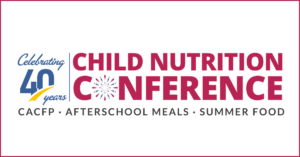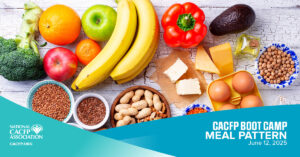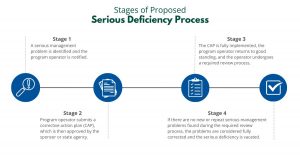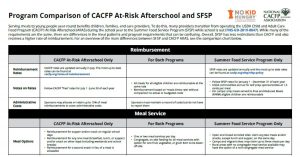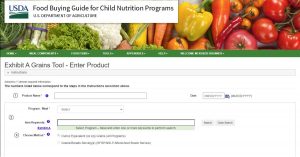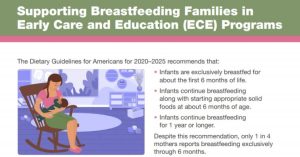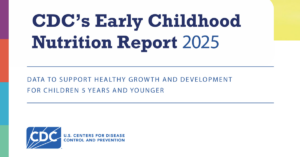Get a rundown on all things happening at NCA this month!
Read MoreUSDA has the authority to waive statutory or regulatory program requirements for Child Nutrition Programs. State Agencies can submit a 12(l) waiver application to USDA in order to allow for flexibilities, including off-site monitoring, in their state. In Fiscal Year 2025, at least nine States have applied and been approved for an off-site monitoring waiver.
Read MoreIf a grain product list enriched grains as the first ingredient, is the product creditable in the CACFP?
Read MoreLearn how to identify gluten-free foods and get a yummy gluten-free snack recipe.
Read MoreA recent study by our partners at Child Care Aware® of America reveals that parents across the nation are struggling to find affordable, high-quality child care. The survey shows that parents are piecing together multiple care arrangements and facing challenges balancing work and caregiving.
Read MoreCan a mixed age group of 1- and 2-year-olds all be served unflavored 1% milk in the CACFP?
Read MoreThe National CACFP Association (NCA) proudly announces the 2026 National Child Nutrition Conference (NCNC26), celebrating 40 years of advancing nutrition in child and adult care settings across the country.
Read MoreThe National CACFP Association (NCA) is reaffirming its commitment to continuing education by offering a variety of virtual training opportunities that support child nutrition professionals at every stage of their careers.
Read MoreServing reimbursable meals begins with a solid understanding of the CACFP meal pattern. Learn more with our Meal Pattern Boot Camp!
Read MoreGet a rundown on all things happening in May at NCA. Annual Training is happening this month. Don’t miss out!
Read MoreWe’re bringing you workshops on nutrition, program administration, operations, financial and nonprofit management, and more.
Read MoreThis year, National CACFP Week was formally recognized at federal and state levels. 17 Governors proclaimed CACFP week in their state and a resolution was introduced in the congressional House of Representatives and the Senate.
Read MoreUSDA released a memo that provides additional information regarding the provisions related to the frequency and number of reviews for State Agencies monitoring the CACFP.
Read MoreUSDA released a proposed rule for updating the Serious Deficiency process in the CACFP and SFSP. The rule proposes updates that would redefines serious deficiency, allows for full correction and removal of serious deficiencies, and extends the process to CACFP unaffiliated centers and SFSP sponsors.
Read MoreUSDA released guidance updating their Question and Answer document for rural non-congregate summer meals. Read the updated guidance.
Read MoreUSDA released guidance to clarify the new criteria States must consider when determining with SFSP sites require pre-approval visits. Read the guidance.
Read MoreFamily child care homes, who are vital to the child care system, especially in rural areas, could lose access to nutritious meals in some states due to the decline in sponsoring organizations.
Read MoreThe Child and Adult Care Food Program has new creditable foods listed on the USDA Food Buying Guide! If you are new to the FBG, this interactive tool allows for easy display, search, and navigation of food yield information. In addition, users can compare yield information, create a favorite foods list, and access tools, such as the Recipe Analysis Workbook (RAW) and the Product Formulation Statement Workbook.
Read MoreThe Child and Adult Care Food Program community asked for more Spanish resources to be available on the National CACFP Sponsors Association website and we heard you! Available now in Spanish are more resources to help sponsors and providers with meal pattern requirements, best practices, and so much more!
Read MoreServing meals to young people year-round benefits children, families, and care providers. To do this, many providers transition from operating the USDA Child and Adult Care Food Program (CACFP) At-Risk Afterschool (ARAS) during the school year to the Summer Food Service Program (SFSP) while school is out. For an overview of the main differences between SFSP and CACFP ARAS, see the comparison chart below.
Read MoreNCA understands that the end of flexibilities will cause challenges for many CACFP sponsors and providers and we commend your continued commitment to providing nutritious meals and snacks to the children or adults in your care. In preparation for the end of the additional reimbursement, we have collected the following resources to help you successfully provide meals even if your available budget decreases.
Read MoreCDC created three new fact sheets for Early Care and Education (ECE) providers about Early Child Nutrition and Feeding. The fact sheets offer tips and best practices for supporting breastfeeding families, information about safe storage and handling of breastmilk, and strategies for introducing solid foods.
Read MoreIf a grain product list enriched grains as the first ingredient, is the product creditable in the CACFP?
Read MoreCan a mixed age group of 1- and 2-year-olds all be served unflavored 1% milk in the CACFP?
Read MoreAre vegetable spirals creditable in the CACFP?
Read MoreCan a provider serve yogurt that they have frozen?
Read MoreCan a pureed vegetable that is mixed into a dish credit towards the meal pattern?
Read MoreAre dehydrated vegetables creditable in the CACFP?
Read MoreThe Child and Adult Care Food Program has new creditable foods listed on the USDA Food Buying Guide! If you are new to the FBG, this interactive tool allows for easy display, search, and navigation of food yield information. In addition, users can compare yield information, create a favorite foods list, and access tools, such as the Recipe Analysis Workbook (RAW) and the Product Formulation Statement Workbook.
Read MoreThe Child and Adult Care Food Program community asked for more Spanish resources to be available on the National CACFP Sponsors Association website and we heard you! Available now in Spanish are more resources to help sponsors and providers with meal pattern requirements, best practices, and so much more!
Read MoreServing meals to young people year-round benefits children, families, and care providers. To do this, many providers transition from operating the USDA Child and Adult Care Food Program (CACFP) At-Risk Afterschool (ARAS) during the school year to the Summer Food Service Program (SFSP) while school is out. For an overview of the main differences between SFSP and CACFP ARAS, see the comparison chart below.
Read MoreNCA understands that the end of flexibilities will cause challenges for many CACFP sponsors and providers and we commend your continued commitment to providing nutritious meals and snacks to the children or adults in your care. In preparation for the end of the additional reimbursement, we have collected the following resources to help you successfully provide meals even if your available budget decreases.
Read MoreCDC created three new fact sheets for Early Care and Education (ECE) providers about Early Child Nutrition and Feeding. The fact sheets offer tips and best practices for supporting breastfeeding families, information about safe storage and handling of breastmilk, and strategies for introducing solid foods.
Read MoreA recent study by our partners at Child Care Aware® of America reveals that parents across the nation are struggling to find affordable, high-quality child care. The survey shows that parents are piecing together multiple care arrangements and facing challenges balancing work and caregiving.
Read MoreThe CDC’s 2025 Early Childhood Nutrition Report gives us a big-picture look at how young children in the U.S. are eating and growing. It focuses on kids from birth to age 5 and shares important facts about breastfeeding, starting solid foods, eating healthy and how states support good nutrition.
Read MoreThe “Characteristics of Emergency Shelters Participating in the CACFP” study by USDA seeks to better understand the characteristics of CACFP emergency shelters, who they serve, how CACFP fits into their operations, and their challenges with CACFP. The study was conducted in 2023 and collected data from 242 emergency shelters that participate in CACFP in Fiscal Year 2023.
Read MoreA survey was administered in the spring of 2023 of licensed California family child care homes (FCCH) to assess the perceived impacts of the increased reimbursement during the Covid-19 pandemic on CACFP participation and anticipated challenges with reinstated tiered rates.
Read MoreThe USDA recently released a study on the “Characteristics of Adult Day Care Centers that Participate in the USDA’s Child and Adult Care Food Program” which seeks to better understand key characteristics of adult day care centers participating in CACFP.
Read MoreUSDA released a survey report focused on SFSP and SSO sponsors who operated the non-congregate meal service option in qualifying rural areas in summer 2023.
Read More






